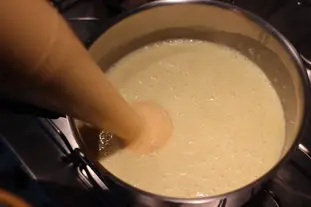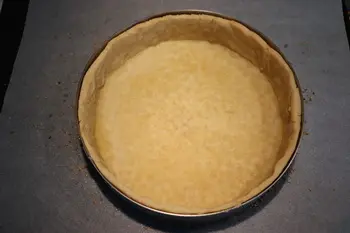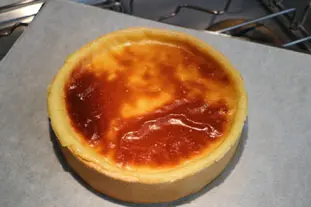This site uses only a few technical cookies necessary for its operation. By continuing to browse, you accept their use.
To find out more...
To find out more...
The 3 secrets of Parisian flan

A flan Parisien, or boulanger, is a simple yet delicious cake. A cream, a mixture of milk, eggs and sugar, is poured into a raw pastry base and baked in the oven until the pastry and cream are cooked.
This is the simplest version of the recipe, probably the original one, but nowadays the cream has changed, and the flan has become a slightly more sophisticated cake, but still delicious, if well made.
Well, here are 3 important points to help you make a good flan.
This is the simplest version of the recipe, probably the original one, but nowadays the cream has changed, and the flan has become a slightly more sophisticated cake, but still delicious, if well made.
Well, here are 3 important points to help you make a good flan.
16 K 4.7/5 (12 reviews)
Keywords for this post:FlanPastryBakeryParisianDoughApplianceMilkCreamEggLast modified on: July 21th 2023
The 3 secrets of Parisian flan
I'll admit it, I'm passionate about flan - I love making it, eating it and talking about it :-).
And to try and get to the bottom of the flan recipe, we're going to look at 3 aspects of it: the dough, the cream to be poured into it (or apparatus), and the cooking.
Traditionally, shortcrust pastry is used, but nowadays we don't hesitate to use sweetcrust pastry (sweeter), puff pastry (crispier) or croissant pastry (crunchier and more delicious).
A flan needs to be thick, much thicker than a tart, and you leave it in the fridge while you work on the mixture.
If you choose puff pastry or croissant dough, I recommend sprinkling a little sugar (about 1 tablespoon) in the bottom of the mold before the dough, as it will caramelize during baking and further enhance the crispness of the pastry.
Proceed in much the same way as for a crème pâtissière: once all the ingredients have been mixed, put on a low heat, stirring constantly until the mixture thickens slightly to reduce baking time and avoid soaking the pastry base with a too-liquid mixture.
To finish, add a little butter and smooth with a mixer. You can find the recipe for the flan maker here.
The basic recipe is a classic vanilla flavor, but you can adapt the recipe to your taste: chocolate, pistachio, lemon, apple, sesame... among others.
A flan should always be placed low in the oven, so that the underside cooks more thoroughly.
If you've pre-cooked both the pastry and the appliance, the cooking time for the two together will be shorter, so keep an eye on the color of the pastry to know, and don't be overly influenced by the shaky texture of the appliance, which is already cooked and will solidify as it cools.
As you can see, it's not a very complicated recipe, but what a result! And above all, what a difference in taste and texture, compared with those poor-quality industrial flans that are unfortunately to be found just about everywhere.
Unfortunately, it's not uncommon to find frozen custards in poor bakeries and other shops, or custards prepared from "mix", i.e. a powder to which milk, or worse, water, is added, to obtain a mediocre mixture which will fill an equally mediocre dough, sometimes made from palm oil...
Of course, these flans are not expensive, which is always suspect, but what a pity for the taste and quality of the products.
To a lesser extent this time, some bakers tend to neglect, or botch up a little, their flan apparatus for economic reasons, and therefore rather top their pastry base with custard than with an apparatus. It's understandable (economically speaking), but it's a shame, because a good bakery should have a good flan.
To make a good flan, you need :
It's up to you!
And to try and get to the bottom of the flan recipe, we're going to look at 3 aspects of it: the dough, the cream to be poured into it (or apparatus), and the cooking.
1) The pastry

Traditionally, shortcrust pastry is used, but nowadays we don't hesitate to use sweetcrust pastry (sweeter), puff pastry (crispier) or croissant pastry (crunchier and more delicious).
A flan needs to be thick, much thicker than a tart, and you leave it in the fridge while you work on the mixture.
If you choose puff pastry or croissant dough, I recommend sprinkling a little sugar (about 1 tablespoon) in the bottom of the mold before the dough, as it will caramelize during baking and further enhance the crispness of the pastry.
2) The mixture

Proceed in much the same way as for a crème pâtissière: once all the ingredients have been mixed, put on a low heat, stirring constantly until the mixture thickens slightly to reduce baking time and avoid soaking the pastry base with a too-liquid mixture.
To finish, add a little butter and smooth with a mixer. You can find the recipe for the flan maker here.
The basic recipe is a classic vanilla flavor, but you can adapt the recipe to your taste: chocolate, pistachio, lemon, apple, sesame... among others.
3) Baking


A flan should always be placed low in the oven, so that the underside cooks more thoroughly.
If you've pre-cooked both the pastry and the appliance, the cooking time for the two together will be shorter, so keep an eye on the color of the pastry to know, and don't be overly influenced by the shaky texture of the appliance, which is already cooked and will solidify as it cools.

The flan and its aberrations
As you can see, it's not a very complicated recipe, but what a result! And above all, what a difference in taste and texture, compared with those poor-quality industrial flans that are unfortunately to be found just about everywhere.
Unfortunately, it's not uncommon to find frozen custards in poor bakeries and other shops, or custards prepared from "mix", i.e. a powder to which milk, or worse, water, is added, to obtain a mediocre mixture which will fill an equally mediocre dough, sometimes made from palm oil...
Of course, these flans are not expensive, which is always suspect, but what a pity for the taste and quality of the products.
To a lesser extent this time, some bakers tend to neglect, or botch up a little, their flan apparatus for economic reasons, and therefore rather top their pastry base with custard than with an apparatus. It's understandable (economically speaking), but it's a shame, because a good bakery should have a good flan.
In a nutshell
To make a good flan, you need :
- The pastry of your choice (no obligation)
- A round mold with high sides (mine is 20 cm long and 4.5 cm high)
- A small amount of powdered sugar
- Pre-bake the pastry on its own
- Pre-bake apparatus
- Bake at the bottom of the oven
It's up to you!
Lasts posts
Butter vs. grease
We often read in a recipe where a pastry is put into a mould that, just before pouring, the mould should be buttered or greased. But what's the difference between these 2 terms?December 1st 20259055
Getting out of the fridge early
Very often when you're cooking, you need to take food or preparations out of the fridge, to use them in the recipe in progress. There's nothing tricky about this: you just take them out of the fridge and use them, usually immediately, in the recipe. But is this really a good method?November 24th 20251,0595
Who's making the croissants?
When you look at a bakery from the outside, you naturally think that in the bakery, the bakers make the bread, and in the laboratory, the pastry chefs make the cakes. It's very often like that, with each of these professions having quite different ways of working, but sometimes there's also one...November 23th 2025955
Oven height
When we put a dish or cake in the oven, we naturally tend to put it on the middle shelf, and that's what we usually do. But in some cases, this position and height can be a little tricky, so let's find out why.October 8th 20252,6255
The importance of sieving
In recipes that use a fine powder (flour, powdered sugar, etc.), you'll often see the advice to sift before using it. To sift is to pass the powder in question through a sieve (a very fine strainer) before incorporating it into your recipe. It's often advice, but is it really useful?September 3rd 20257,4633
Other pages you may also like
What is the difference between bakery and patisserie?
This is a question that you may well have asked yourself and which I will attempt to answer. In France the two trades of "boulangerie" (bakery) and "pâtisserie" (patisserie and confectionery) have always been quite distinct, but where exactly do the boundaries lie? .February 7th 2017134 K 14.1
The return of the "Norman hole"
You maybe know the "trou normand", this old gastronomic custom typically French which consists in taking a (small) glass of calvados, generally between the last course and the dessert? It's something that seems a bit anachronistic nowadays, having a glass of an alcohol of more than 60° in the...December 18th 202115 K4.8
The super powers of cornstarch
I start this new year by evoking an old product, that you most probably have in your cupboards, a white powder, often in a small cardboard package with a slightly outdated look, only the "gluten free" is relatively recent, it is simply cornstarch, hence its name of maïzena. It's used for a lot...January 14th 202215 K
How to sprinkle well?
When in a recipe you need to sprinkle something, that is to say to spread a fine layer of powder (flour, sugar, etc.) on something, powdered sugar on a pie for example, you will probably use a fine strainer or a sieve, this is the best way to proceed. But is that all?May 23th 202310 K4.7
No need to boil gelatin
Gelatin is a magical ingredient for making light, creamy, structured desserts, yet it's often misused in the kitchen. A common mistake in some recipes is the idea that it needs to be boiled for it to work properly, but this is a mistake indeed: gelatin melts at a much lower temperature, around...November 21th 20248,1905
Post a comment or question
Follow this page
If you are interested in this page, you can "follow" it, by entering your email address here. You will then receive a notification immediately each time the page is modified or a new comment is added. Please note that you will need to confirm this following.
Note: We'll never share your e-mail address with anyone else.
Alternatively: you can subscribe to the mailing list of cooling-ez.com , you will receive a e-mail for each new recipe published on the site.









